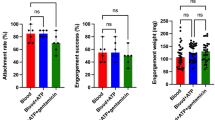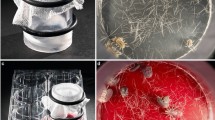Abstract
We examined the effectiveness of bovine cholesterol concentrate in reducing the high level (10–20%) of fetal bovine serum (FBS) necessary to promote tick cell growth in vitro. Tick cell lines isolated from embryos ofAnocentor nitens (ANE 58),Boophilus microplus (BME 26), andRhipicephalus appendiculatus (RAE 25) were used. They were incubated in L-15 (BME 26) or L-15B (ANE 58 and RAE 25) supplemented with 10% tryptose phosphate broth (TPB), 5% (ANE 58 and BME 26) or 3% FBS, 10–90 μm/ml cholesterol. A concentration of 10 μg/ml cholesterol stimulated the growth rate of all three lines but more than 30 μg/ml depressed growth in ANE 58 and RAE 25 cells, while multiplication of BME 26 cells was enhanced by all cholesterol concentrations tested. All three lines could be continuously grown in 5% FBS, provided that 10 μg/ml cholesterol was included.
Nutrients added to L-15 in the formulation of L-15B were tested singly or in combination for their ability to support tick cell growth in medium supplemented only with 5% FBS and 10 μm/ml cholesterol. In L-15 alone, RAE 25 cells did not multiply. Adding glucose (Glc), glutamic acid (Glu), or α-ketoglutaric acid (αK) had little or no effect, and the same was true for combinations of Glc plus α K, aspartic acid (Asp) plus proline (Pro) and glutamine (Gln), and minerals plus vitamins (MV). When Asp, Gln, Pro, and αK were combined with Glc and/or MV and added to L-15, there was appreciable growth stimulation, but best results were obtained when Glu was also included. In this medium, i.e., L-15B with 5% FBS and 10 μ/ml cholesterol, lines BME 26 and RAE 25 could be continuously subcultured.
Similar content being viewed by others
References
Anonymous, 1984. Difco Manual, 10th edition. Difco Laboratories, Inc., Detroit, MI.
Bassal, T.T.M., 1986. Some aspects of carbohydrate biochemistry in ticks. In: J.R. Sauer and J.A. Hair (Editors), Morphology, Physiology, and Behavioral Biology of Ticks. Ellis Horwood, Chichester, pp. 280–298.
Bhat, U.K.M. and Yunker, C.E., 1977. Establishment and characterization of a diploid cell line from the tickDermacentor parumapertus Neumann (Acarina: Ixodidae). J. Parasitol., 63: 1092–1098.
Bittles, A.H., 1974. The comparative analysis of three batches of foetal bovine serum used in tissue culture. Med. Lab. Technol., 31: 253–255.
Brooks, M.A., 1964. Symbiotes and the nutrition of medically important insects. Bull. WHO, 31: 555–559.
Brooks, M.A., Tsang, K.R. and Freeman, F.A., 1980. Cholesterol as a growth factor for insect cell lines. In: E. Kurstak, K. Maramorosch and A. Dübendorfer (Editors), Invertebrate Systems In Vitro. Elsevier/North-Holland Biomedical, Amsterdam, pp. 67–77.
Brown, S.E. and Knudson, D.L., 1982. Characterization of invertebrate cell lines. IV. Isozyme analyses of dipteran and acarine cell lines. In Vitro, 18: 347–350.
Chippendale, G.M., 1978. The function of carbohydrates in insect life processes. In: M. Rockstein (Editor), Biochemistry of Insects. Academic Press, New York, pp. 1–55.
Droleskey, R.E., Holman, P.J., Craig, T.M., Wagner, G.G. and Mollenhauer, H.H., 1983. Ultrastructure ofBabesia bovis sexual stages as observed inBoophilus microplus cell cultures. Res. Vet. Sci., 34: 249–251.
Holman, P.J. and Ronald, N.C., 1980. A new tick cell line derived fromBoophilus microplus. Res. Vet. Sci., 383–387.
Honn, K.V., Singley, J.A. and Chavin, W., 1975. Fetal bovine serum: a multivariate standard. Proc. Soc. Exp. Biol. Med., 149: 344–347.
Keeley, L.L., 1984. Physiology and biochemistry of the fat body. In: G.A. Kerkut and L.I. Gilbert (Editors), Comprehensive Insect Physiology, Biochemistry and Pharmacology, 3. Pergamon Press, Oxford, pp. 211–248.
Kurtti, T.J. and Munderloh, U.G., 1982. Tick cell culture: characteristics, growth requirements, and applications to parasitology. In: K. Maramorosch and J. Mitsuhashi (Editors), Invertebrate Cell Culture Applications. Academic Press, New York, pp. 195–232.
Kurtti, T.J. and Munderloh, U.G., 1983. The effects of 20-hydroxyecdysone and juvenile hormone III on tick cells. J. Parasitol., 69: 1072–1078.
Kurtti, T.J. and Munderloh, U.G., 1988.Borrelia burgdorferi in tick cell culture. Growth and cellular adherence. J. Med. Entomol., 25: 256–261.
Kurtti, T.J., Munderloh, U.G. and Samish, M., 1982. Effects of medium supplements on tick cells in culture. J. Parasitol., 68: 930–935.
Kurtti, T.J., Munderloh, U.G., and Stiller, D., 1983. The interaction ofBabesia caballi kinetes with tick cells. J. Invert. Pathol., 42: 334–343.
Kurtti, T.J., Munderloh, U.G. and Krych, V., 1985. Culture of tick and mosquito cells with reduced serum requirements. In: Third International Cell Culture Congress, 10–13 September 1985, Sendai, Japan. Abstract (unpubl.).
Leibovitz, A., 1963. The growth and maintenance of tissue-cell cultures in free gas exchange with the atmosphere. Am. J. Hyg., 78: 173–180.
Lowry, O.H., Rosebrough, N.J. Farr, A.L. and Randall, R.J., 1951. Protein measurement with the Folin phenol reagent. J. Biol. Chem., 193: 265–271.
McCall, H., 1978. Effect of salivary stimulants on isolated preparations ofTheileria parva-infected and non-infected salivary glands ofR. appendiculatus. In: J.K.H. Wilde (Editor), Tick-Borne Diseases and their Vectors. Lewis Reprints, Ltd., Tonbridge, Great Britain, pp. 343–350.
Mitsuhashi, J., 1982. Determination of essential amino acids for insect cell lines. In: K. Maramorosch and J. Mitsuhashi (Editors), Invertebrate Cell Culture Applications. Academic Press, New York, pp. 9–51.
Munderloh, U.G. and Kurtti, T.J., 1985. Malarial parasites complete sporogony in axenic mosquitoes. Experientia, 41: 1205–1207.
Neitz, A.W.H., Howell, C.J., Potgieter, D.J.J. and Bezuidenhout, J.D., 1978. Proteins and free amino acids in the salivary secretion and hemolymph of the tickAmblyomma hebraeum. Onderstepoort J. Vet. Res., 45: 235–240.
Parker, R., Ribi, E. and Yunker, C.E., 1972. Application of centrifugal chromatography to the separation of sugars in arthropod hemolymph and tissue culture medium. In: J.G. Rodriguez (Editor), Insect and Mite Nutrition. North-Holland, Amsterdam, pp. 397–406.
Proksch, G.J. and Bonderman, D.P., 1976. Use of a cholesterol-rich bovine lipoprotein to enhance cholesterol concentrations in the preparation of serum control materials. Clin. Chem., 22: 1302–1305.
Pudney, M., Varma, M.G.R. and Leake, C.J., 1979. Establishment of cell lines from ixodid ticks. TCA Man., 5: 1003–1007.
Pudney, M., Leake, C.J. and Buckley, S.M., 1982. Replication of aboviruses in arthropod in vitro systems: an overview. In: K. Maramorosch and J. Mitsuhashi (Editors), Invertebrate Cell Culture Applications. Academic Press, New York, pp. 159–194.
Řeháček, J. and Brezina, R., 1964. Propagation ofCoxiella burneti in tick tissue cultures. Acta Virol., 8: 380.
Řeháček, J. and Brzostowski, H.W., 1969a. A tick tissue culture medium based on analyses of hemolymph. J. Insect Physiol., 15: 1431–1436.
Řeháček, J. and Brzostowski, H.W., 1969b. The utilization of amino acids and sugars by tick cells cultivated in vitro. J. Insect Physiol., 15: 1683–1686.
Samish, M., Louloudes, S.J., Vaughn, J.L., Kurtti, T.J. and Munderloh, U.G., 1985. Promotion of tick cell growth by proline and fractions from tick eggs. Int. J. Parasitol., 15: 21–26.
Varma, M.G.R., Pudney, M. and Leake, C.J., 1975. The establishment of three cell lines from the tickRhipicephalus appendiculatus (Acari: Ixodidae) and their infection with some arboviruses. J. Med. Entomol., 11: 698–706.
Yunker, C.E. and Meibos, H., 1979. Culture of embryonic tick cells. TCA Man., 5: 1015–1017.
Yunker, C.E., Cory, J. and Meibos, H., 1981a. Continuous cell lines from embryonic tissues of ticks (Acari: Ixodidae). In Vitro, 17: 139–142.
Yunker, C.E., Cory, J., Gresbrink, R.A., Thomas, L.A. and Clifford, C.M., 1981b. Tickborne viruses in western North America III. Viruses from man-biting ticks (Acari: Ixodidae) in Orgeon. J. Med. Entomol., 18: 457–463.
Yunker, C.E., Tully, J.G. and Cory, J., 1987. Arthropod cell lines in the isolation and propagation of tickborne spiroplasmas. Curr. Microbiol., 15: 45–50.
Author information
Authors and Affiliations
Rights and permissions
About this article
Cite this article
Munderloh, U.G., Kurtti, T.J. Formulation of medium for tick cell culture. Exp Appl Acarol 7, 219–229 (1989). https://doi.org/10.1007/BF01194061
Accepted:
Issue Date:
DOI: https://doi.org/10.1007/BF01194061




